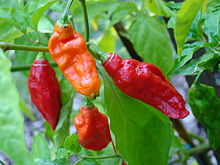
Back Scoville-skaal Afrikaans مقياس سكوفيل Arabic Скала на Сковил Bulgarian Escala Scoville Catalan Scovilleova stupnice Czech Scoville Danish Scoville-Skala German Κλίμακα Σκόβιλ Greek Escala Scoville Spanish Scoville eskala Basque



The Scoville scale is a measurement of pungency (spiciness or "heat") of chili peppers and other substances, recorded in Scoville heat units (SHU). It is based on the concentration of capsaicinoids, among which capsaicin is the predominant component.[3]
The scale is named after its creator, American pharmacist Wilbur Scoville, whose 1912 method is known as the Scoville organoleptic test.[3][4] The Scoville organoleptic test is a subjective assessment derived from the capsaicinoid sensitivity by people experienced with eating hot chilis.[3]
An alternative method, high-performance liquid chromatography (HPLC), can be used to analytically quantify the capsaicinoid content as an indicator of pungency.[3][5][6]
- ^ Barry-Jester, Anna Maria (October 15, 2014). "Rating Chili Peppers On A Scale Of 1 To Oh Dear God I'm On Fire". FiveThirtyEight. Retrieved 2014-11-02.
- ^ "Some Like It Hot: Dorset's Ultra-Hot Chillies". Archived from the original on 19 November 2012. Retrieved 25 August 2010.
- ^ a b c d Twilight Greenaway (10 January 2013). "How Hot is That Pepper? How Scientists Measure Spiciness". Smithsonian.com, US Smithsonian Institution. Retrieved 17 December 2017.
- ^ Scoville, Wilbur (May 1912). "Note on Capsicums". Journal of the American Pharmaceutical Association. 1 (5): 453–454. doi:10.1002/jps.3080010520.
- ^ Cite error: The named reference
collinswas invoked but never defined (see the help page). - ^ Al Othman, Zeid Abdullah (2011). "Determination of Capsaicin and Dihydrocapsaicin in Capsicum Fruit Samples using High Performance Liquid Chromatography". Molecules. 16 (10): 8920. doi:10.3390/molecules16108919. PMC 6264681. PMID 22024959.